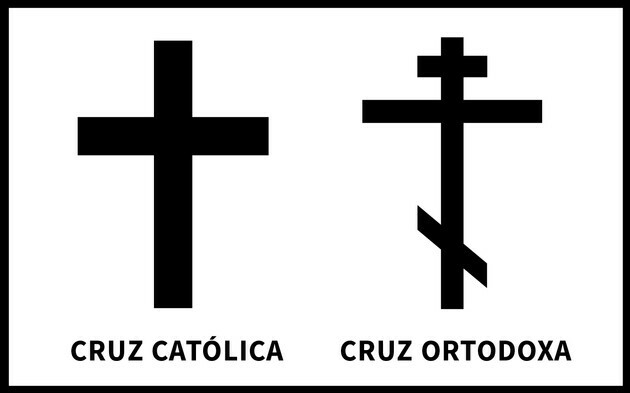The Roman Catholic Church and the Orthodox Catholic Church are strands of Christianity that differ in matters of customs and doctrine.
The most obvious would be the question of Church leadership. The Roman Catholic Church believes in the primacy of one of the bishops, the Bishop of Rome, who is the pope and he is the highest authority in that church.
On the other hand, the Orthodox do not believe in the supremacy of any bishop, since they are all equal. Only the Patriarch of Constantinople is given special deference, being considered primus inter pares (the first among his peers).
Due to a split in 1054, some of their rituals, beliefs and even symbols are different. Understand the differences better:
| Catholic church | orthodox church | |
|---|---|---|
| pope | It is the ultimate authority. | There is no ultimate church authority. Its highest hierarchy is a collegiate of bishops, presided over by the Patriarch of Constantinople. |
| Celibacy for priests | Celibacy is mandatory for all priests. | Celibacy for priests is mandatory. However, a married man can become a priest. This rule, however, does not apply to bishops. |
| Calendar | They follow the Gregorian calendar. | They use the Julian calendar, which is 13 days ahead of the Gregorian calendar. |
| Cross | Cross with only one horizontal bar. | The orthodox cross has 3 bars. |
| lent | 40 days. | 47 days. |
| language in cults | Previously, Latin was used. Today the local language is used. | Use the local language. |
| Images | They use three-dimensional (statues) and two-dimensional (pictures) images to represent the saints. | They don't use statues, just two-dimensional images. |
| power in history | The pope sought to assert his power above kings and rulers. | Emperors had power above the patriarch and bishops and acted in close collaboration with the church. |
| Prayer | They usually pray kneeling. | They usually pray standing up. |
| Purgatory | Believe in purgatory. | They don't believe in purgatory. |
Division of the Catholic and Orthodox Church
Christendom had already split between Nestorian and pre-Chalcedonian churches (which did not accept the Council of Chalcedon in the year 451). However, it maintained its unit within the territory corresponding to the Roman Empire.
However, after the fall of the Roman Empire in the West, the differences between Christianity practiced in the West and in the East were accentuated.
Cultural distinctions and power struggles led to the breakup of the two strands. The difference in language and the questioning of papal authority culminated in the separation of the churches in 1054, in an episode known as the "Eastern Schism".
Thus, those who today call themselves the Roman Catholic Church were rooted in Western Europe. Those who became Orthodox Catholics were concentrated in Eastern Europe and the Middle East.
Currently, with persecution undertaken in some Muslim countries, there are more Orthodox Catholics in the West than in the East.
symbol of the cross

While the Roman Catholic cross has only one bar, the Orthodox Catholic cross has three.
The top bar represents where the inscription INRI (Jesus of Nazareth, King of the Jews) was placed and the center bar, where Jesus' arms were nailed. Finally, the last bar would be for the support of Jesus' feet.
Differences in rituals
In the past, the language used during services was a big difference between the two strands. While in the Roman Catholic Church services were held in Latin, in the Orthodox Church native languages such as Greek, Hebrew or Russian were used.
In these churches there is also a difference about the use of images. In the Roman Catholic Church both statues and paintings are used, while in the Orthodox Catholic the faithful do not venerate statues.
Another difference is in the way of praying. While Roman Catholics usually pray while kneeling, Orthodox do so while standing.
Hierarchy and Primacy of the Pope

One of the biggest differences between the two streams of Christianity is in their view of the pope.
The Roman Catholic Church believes in papal primacy. The Orthodox, on the other hand, despite recognizing the pope as the Bishop of Rome and the first of Christendom, reject his supremacy in church government and his infallibility in matters of morals and faith.
In the Orthodox Church, the highest office in the hierarchy is that of the Patriarch of Constantinople, who, like the pope, is the symbol of church unity.
Unlike the Roman Catholic Church, which has its headquarters in the Vatican, the Orthodox Church adds the locality where it is located to its name. Thus there is the Russian Orthodox Church, under the jurisdiction of the Patriarch of Moscow, and the Romanian Orthodox Church, which is headed by the Patriarch of Romania.
Both are considered the same church, but have different leaders.
The patriarch does not have full authority, so neither can interfere with the other's jurisdiction.
Calendar and commemorative dates
Due to the lag of days between the Julian and Gregorian calendars, Easter and Christmas dates are celebrated on different days. While Roman Catholic Christmas is celebrated on the 25th of December, the Orthodox celebrate it on the 7th of January.
There is also a difference in the length of Lent time. For Roman Catholics, the period lasts 40 days, for Orthodox it lasts 47.
The difference is explained by the fact that Roman Catholics do not include Sundays in the reckoning of Lent. For their part, Orthodox Catholics count Sundays in the final sum.
See also the difference between:
- Being Catholic and being Christian
- Protestants and Evangelicals
- creationism and evolutionism
- High Middle Ages and Low Middle Ages


